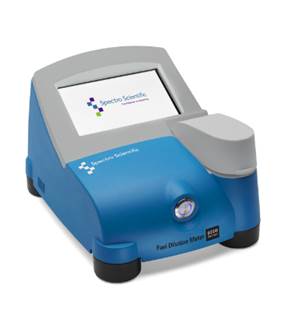燃油稀释
燃油稀释检测
燃油稀释到润滑油中会导致严重的发动机损坏。润滑油中的高剂量燃料(>2%)会导致粘度降低、润滑油降解、均匀性和氧化稳定性下降。燃料稀释是内燃机中最主要的润滑剂失效原因之一。通常是燃空比不当造成的。过度怠速、活塞环磨损、喷油器故障或接头松动也可能导致燃油稀释。
检测技术:► 表面声波传感
斯派超FDM 6000 燃油稀释仪使用表面声波传感器(SAW),该传感器专门针对燃油蒸汽。在封闭的样品容器中,油中稀释的燃料量与处于平衡状态的封闭样品容器顶部的燃油蒸汽量成正比。将半毫升样品放在一次性小瓶底部的小毛毡垫上。静置一分钟,然后FDM使用尖刺刺穿盖子对蒸汽进行采样。FDM是一种简单、直接、便携的仪器,既可以在实验室,又可以在现场使用。没有经过详细培训的专业人员也可以轻松使用它。燃料稀释的测量范围为0-15%,LOD为0.2%。重复性RSD<5%,精度为测量的±10%(燃料稀释率至少为0.2%)。
►粘度
粘度测试通常为润滑剂状态基本检测的一部分。有许多方法和仪器可用于实验室和现场检测,包括斯派超MiniVisc 3050便携式运动粘度计。润滑剂中的燃料稀释可以通过粘度间接检测,其表现为相较与未受污染油的变化。但是,润滑剂出现出的粘度变化并不一定是由燃料稀释造成的。许多其他原因也会造成粘度的变化:润滑剂降解、污染(水、冷却液、烟灰)、加注错误的润滑油等。粘度最好用作筛选测试,以方便必要时对问题样品的进行进一步测试。
► 闪点测试
闪点测试是几十年来一直用于评估新润滑油和废油的标准方法。它可以检测在已使用油样中存在的燃料稀释。闪点是点火源在设定条件下点燃样品蒸汽的最低温度。当润滑剂中存在较轻碳氢化合物燃料成分时,闪点温度将降低。
一种常用的方法是ASTM D3828,也称为小规模闭杯方法。此方法仅使用2 mL样品,样品被快速加热到低于新油基线的温度,以预设量进行通过/失败测试(例如25°C)。一旦达到目标温度,点火器就会点火。如果有闪光出现,则表明可能存在燃料稀释。为了获得更加定量的结果,可以尝试多个温度点,并使用基于已知样品生成的相关表格将闪点温度转换为燃料稀释百分比。由于燃料类型和发动机润滑油的类型可能未知,因此很难确定燃料稀释的实际百分比。所以,闪点测试通常用作定性通过/失败测试。
► FTIR红外光谱仪
FTIR光谱为燃料稀释提供了快速,用户界面友好的检测方法,但是要区分燃料碳氢化合物和润滑油基础油中存在的碳氢化合物并不容易。要获得准确的结果是非常困难的。校准需要样本类型范围狭窄的大型数据集,以便开发将光谱与燃料稀释相关联的复杂算法。因此,FTIR并未广泛用于燃料稀释测量。
►气相色谱
最为广泛采用的用于分析润滑剂中燃料稀释的直接方法是气相色谱(GC),根据ASTM D3524,D3525,以及最近的D7593.4-6标准,该方法将部分油样注入气相色谱仪。GC使样品汽化并使其通过分析柱,分析柱按沸点顺序将样品分离成不同的碳氢化合物。定量结果通过FID(火焰电离检测器)检测到的燃料峰总面积获得的。绘制校准曲线,将峰值面积与油中燃料的百分比质量相关联。有时使用内部标准(如柴油的癸烷),因此校准燃料峰值的总面积与内部标准峰值面积的比率。
这些方法可以提供高度准确的结果,但它们价格昂贵且需要经验丰富的技术人员,所以仅适用于进行大批量检测的实验室。使用GC分析获得最佳结果可能非常耗时,因为在某些情况下,燃料和某些发动机油组成成分之间的沸点存在重叠。如果不加以控制,这些重叠可能会引起高达2%的燃料稀释误差。在这种情况下,可能需要针对特定油型优化温度、压力或分析柱。许多商业实验室已经改进了传统的ASTM方法,转而采用由领先的GC制造商开发的更快,更强的方法。
总结
燃料稀释是一个重要的润滑剂污染问题,可能导致严重的发动机损坏。有几种方法可用于测量燃料稀释。粘度是一种很好的筛选方法,传统上是作为废油检测的一部分进行。直接方法包括气相色谱、闪点测试和SAW检测方法。需求不同,对应的最佳方法也不尽相同。
获取免费电子指南并了解更多信息

